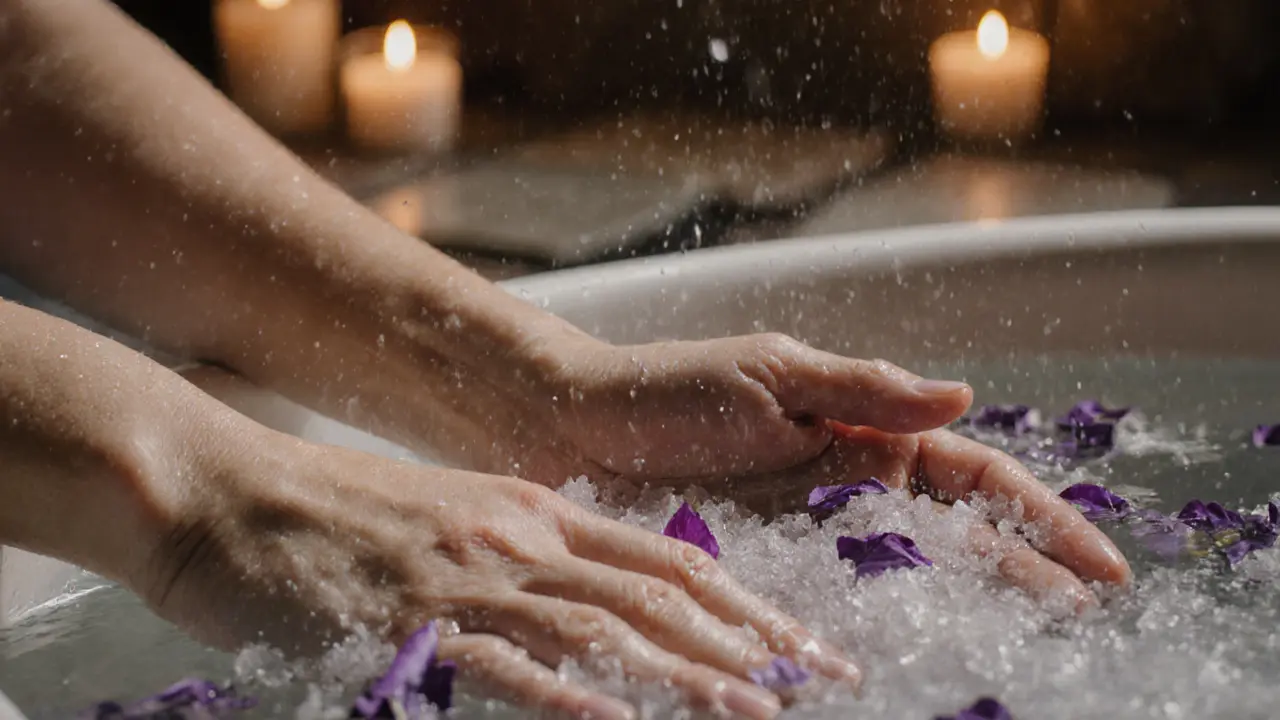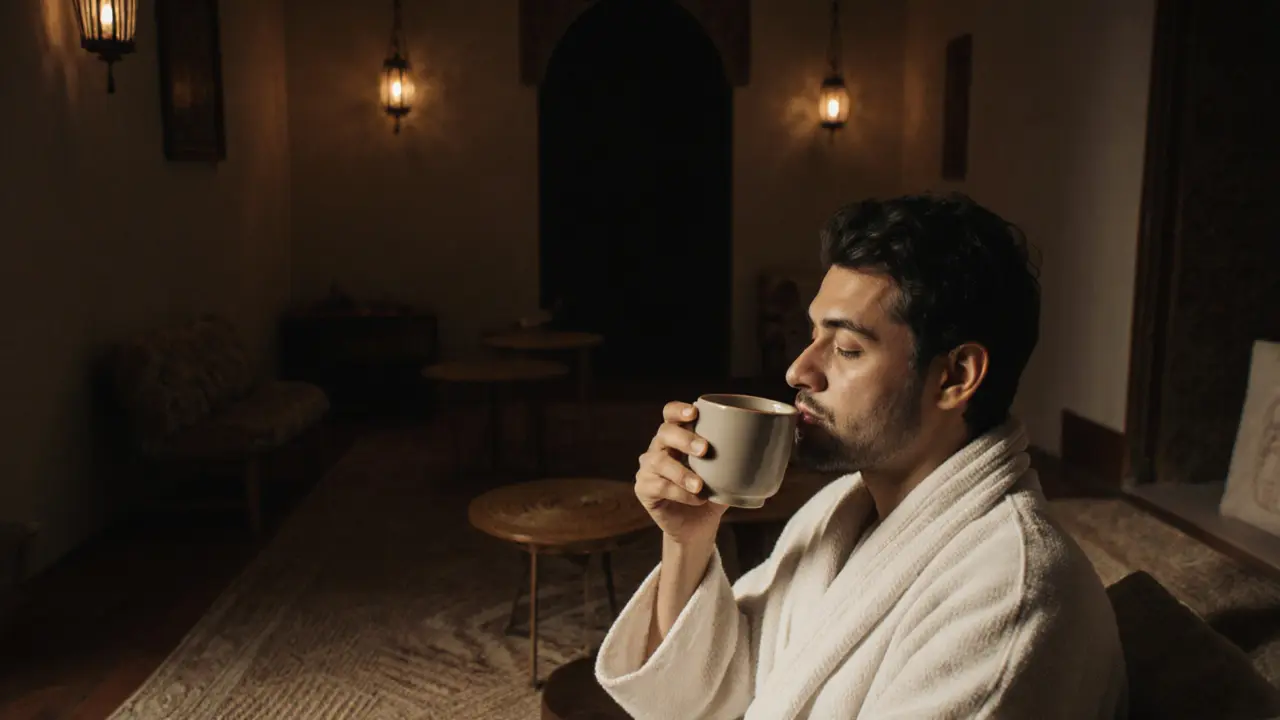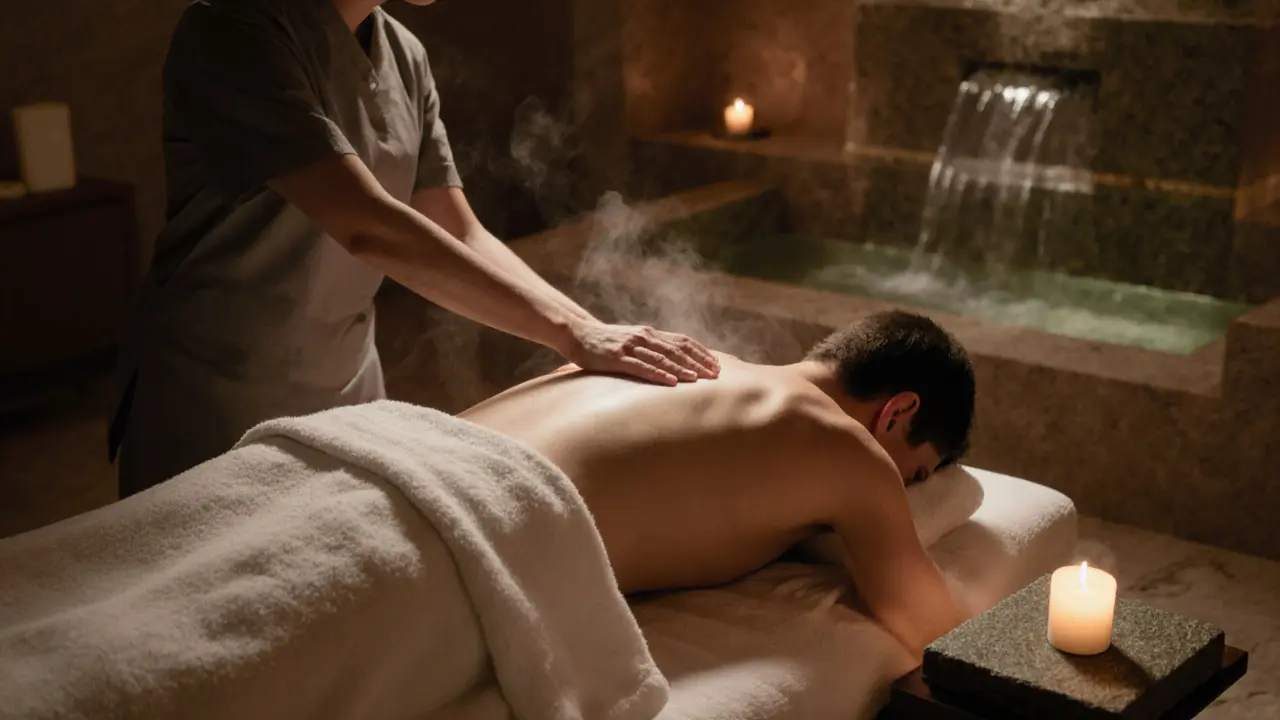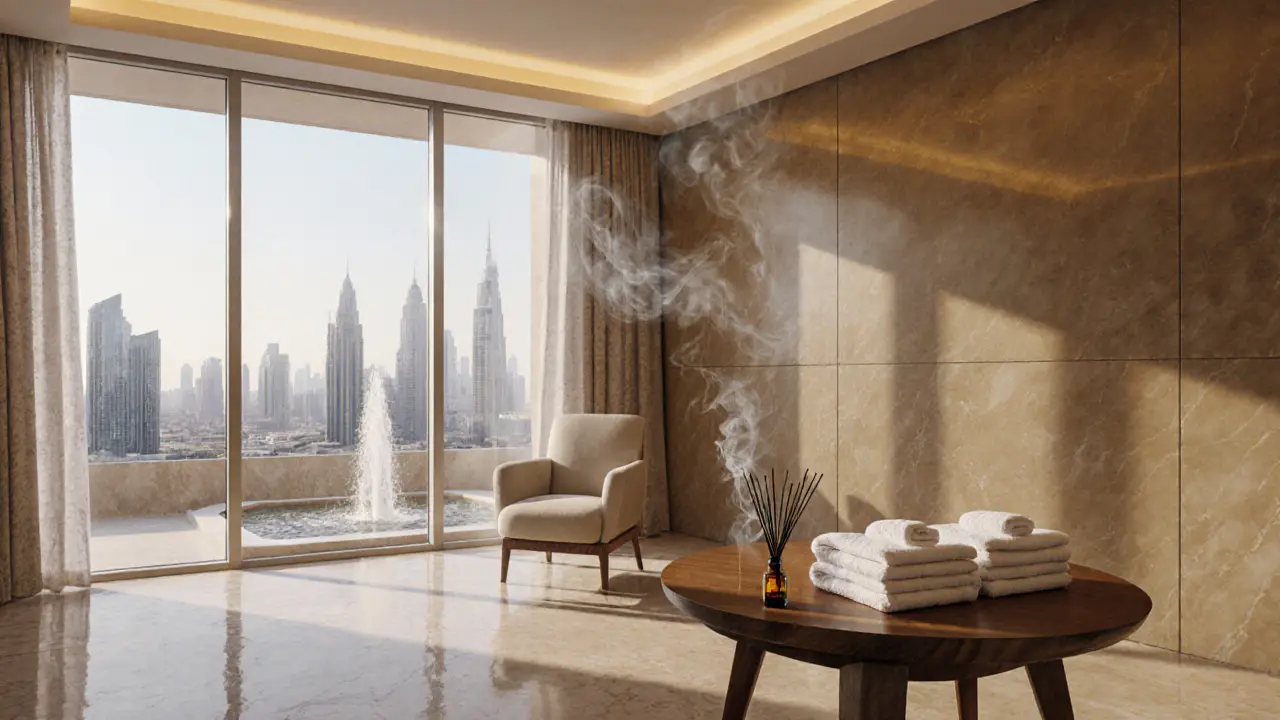What Does SPA Stand For? The Real Meaning Behind the Word Everyone Uses
When you hear the word spa, you probably think of steam rooms, massages, and quiet moments away from the noise of daily life. But what does spa actually stand for? It’s not an acronym you’d find on a corporate logo - it’s older than you think, rooted in history, and far more meaningful than just a place to get a facial.
Most people assume spa is short for Sanitas Per Aquam - Latin for health through water. And while that’s the most popular explanation, it’s not the whole story. The truth is more grounded in a tiny town in Belgium, centuries of healing traditions, and the way cultures around the world have always turned to water for renewal. Whether you’re sipping mineral water in Thermal Springs or getting a hot stone massage in Dubai, you’re taking part in a practice that’s been refined for over 2,000 years.
This isn’t just about luxury. It’s about how humans have always used water, heat, and stillness to reset their bodies and minds. Let’s break down where the word came from, what it really means today, and why it still matters in our busy, screen-filled lives.
Understanding the Basics of SPA
Origins and History
The word spa comes from the name of a small town in Belgium called Spa. Since Roman times, people have traveled there to drink and bathe in its naturally warm, mineral-rich springs. By the 16th century, Spa had become a fashionable destination for European nobility seeking relief from illness, fatigue, and stress. It wasn’t just about relaxation - it was medical therapy.
Over time, the name of the town became synonymous with any place offering water-based healing. By the 1800s, spa towns popped up across Europe and North America. In the 1970s, the term broadened again - this time to include any wellness-focused retreat offering massages, saunas, and aromatherapy. Today, even a hotel with a small hot tub calls itself a spa. But the original spirit remains: water, rest, and intentional care.
Core Principles or Components
At its heart, a spa is built on three simple pillars: water, heat, and stillness.
- Water - Whether it’s a mineral spring, a hot tub, or a hydrotherapy pool, water is the foundation. It’s weightless, soothing, and helps muscles relax.
- Heat - Warmth increases circulation, eases joint pain, and triggers the body’s natural healing response. Think saunas, steam rooms, and heated stone treatments.
- Stillness - This is the quiet part. No phones. No deadlines. Just breathing. Stillness lowers cortisol, slows your heart rate, and gives your nervous system a chance to reset.
These aren’t just nice extras - they’re biological tools. Research from the National Institutes of Health shows that heat and water immersion can reduce inflammation and improve sleep quality (Web source (https://www.nih.gov)).
How It Differs from Related Practices
People often mix up spa treatments with other wellness practices. Here’s how spa stands apart:
| Practice | Key Feature | Primary Benefit |
|---|---|---|
| Spa | Water + heat + passive relaxation | Physical reset and nervous system calm |
| Yoga | Active movement + breath control | Mind-body connection and flexibility |
| Massage Therapy | Targeted muscle manipulation | Relief from tension and pain |
| Med spa | Medical procedures (e.g., Botox, lasers) | Aesthetic improvement |
A spa doesn’t ask you to do anything. You don’t stretch, hold poses, or sign consent forms. You just show up, soak, and let your body unwind. That’s its power.
Who Can Benefit from SPA?
Anyone who feels tired, stiff, or overwhelmed. That’s most of us.
Office workers in Dubai who sit all day? Spas help with lower back pain and poor circulation. New parents? A quiet 90-minute soak can restore mental clarity. Athletes? Hydrotherapy reduces muscle soreness faster than ice baths alone. Even people managing chronic stress or anxiety find relief - not because a spa cures them, but because it gives their nervous system a chance to pause.
It’s not about being rich or fit. It’s about needing a reset. And that’s something every human deserves.
Benefits of SPA for Body and Mind
Stress Reduction
When you step into a warm bath or lie under heated stones, your body shifts from fight-or-flight mode to rest-and-digest. Your heart rate slows. Your breathing deepens. Cortisol - the stress hormone - drops.
Studies from the American Psychological Association show that even a single spa session can lower stress markers for up to 48 hours. In a city like Dubai, where life moves fast and temperatures soar, this isn’t a luxury - it’s a necessity.
Enhanced Functionality
Spa treatments improve circulation. That means more oxygen and nutrients reach your muscles, joints, and skin. Better circulation = less stiffness, faster recovery, and even improved digestion.
Hydrotherapy, in particular, helps people with arthritis or joint pain move more freely. It’s not magic - it’s physics. Water supports your body, reducing pressure on joints while still allowing movement.
Emotional Well-Being
Spas don’t just relax your muscles - they quiet your mind. The combination of warmth, quiet, and gentle touch triggers the release of endorphins and serotonin. Many people report feeling lighter, clearer, and more centered after a session.
It’s not therapy, but it can feel like it. One woman in Dubai told me, “I go once a month. It’s the only time I don’t think about work, my kids, or what’s next. I just… breathe.”
Practical Applications
You don’t need a fancy spa to get the benefits. Try this:
- Take a 20-minute warm bath before bed with Epsom salts.
- Use a heating pad on your shoulders for 15 minutes after a long day.
- Turn off your phone and sit in a steamy bathroom for 10 minutes after a shower.
These small acts add up. They’re not replacements for medical care - but they’re powerful tools for daily resilience.
| Benefit | Description | Impact |
|---|---|---|
| Stress Reduction | Lowers cortisol, slows heart rate | Improved sleep, better mood |
| Pain Relief | Heat eases muscle and joint tension | Greater mobility, less stiffness |
| Detox Support | Sweating helps eliminate toxins | Clearer skin, improved energy |
| Mental Clarity | Quiet space resets mental overload | Better focus, reduced anxiety |
What to Expect When Engaging with SPA
Setting or Context
A good spa feels intentional. Soft lighting. Quiet music. The smell of eucalyptus or lavender. The hum of water. No loud conversations. No flashing screens.
In Dubai, high-end spas often blend modern design with Middle Eastern touches - copper lanterns, sandstone walls, and intricate tilework. But even a simple hotel spa can feel sacred if the atmosphere is respected.
Key Processes or Steps
Here’s what typically happens in a standard spa session:
- You check in and fill out a brief health form.
- You’re guided to a changing room and given a robe and slippers.
- You may start with a sauna or steam room to open your pores.
- You receive your treatment - massage, body wrap, facial, or hydrotherapy.
- You rest in a quiet lounge with herbal tea afterward.
The whole process is designed to ease you in - not overwhelm you.
Customization Options
Spas aren’t one-size-fits-all. You can choose:
- Pressure level for massage (light, medium, deep)
- Essential oils (lavender for calm, citrus for energy)
- Temperature of water or stones
- Length of time (60, 90, or 120 minutes)
Always speak up. If the room is too cold, the oil smells too strong, or the music is too loud - say something. A good spa wants you to be comfortable.
Communication and Preparation
Before your session, drink water. Avoid heavy meals. Let the therapist know if you have injuries, allergies, or are pregnant. If you’re nervous, tell them. Most therapists have heard it all - and they’re there to help you feel safe.

How to Practice or Apply SPA
Setting Up for Success
You don’t need a spa to create a spa moment. At home:
- Turn off your phone.
- Light a candle or use essential oil diffuser.
- Warm a towel in the dryer.
- Play nature sounds or silence.
Even 20 minutes of quiet warmth can reset your day.
Choosing the Right Tools/Resources
If you’re visiting a spa, look for:
- Certified therapists (ask about training)
- Clean, well-maintained facilities
- Transparent pricing
- Positive reviews from locals
In Dubai, many resorts offer spa packages - but don’t assume more expensive means better. Sometimes a quiet hotel spa with a skilled therapist beats a flashy resort with rushed staff.
Step-by-Step Guide
Here’s how to create a spa experience at home:
- Fill your bathtub with warm (not hot) water.
- Add 1-2 cups of Epsom salts or sea salt.
- Light a candle and play soft music.
- Soak for 20-30 minutes. Breathe deeply.
- Afterward, wrap yourself in a warm towel and sip herbal tea.
No fancy equipment needed. Just time and intention.
Tips for Beginners or Couples
First-timers often feel awkward. That’s normal. Remember: everyone else is there to relax, not judge.
If you’re going with a partner, agree on quiet time. Don’t talk about work or kids. Just breathe together. Many couples say it’s the only time they truly disconnect - and reconnect.
Safety and Ethical Considerations
Choosing Qualified Practitioners/Resources
Always ask about training. A licensed massage therapist has completed certified coursework. A “spa attendant” might not. Look for credentials from organizations like the International Spa Association or local health boards.
Safety Practices
Spas are generally safe - but only if they follow basic rules:
| Practice | Purpose | Example |
|---|---|---|
| Sanitize tubs and tools | Prevent infection | Disinfect after each guest |
| Keep water temperature under 40°C | Avoid burns | Hot tubs should never scald |
| Ask about allergies | Prevent reactions | Use fragrance-free oils if sensitive |
Setting Boundaries
You own your body. If a therapist touches you in a way that feels wrong, say so. You can ask them to stop, adjust pressure, or leave the room. A good spa respects boundaries - always.
Contraindications or Risks
Spas aren’t for everyone. Avoid them if you:
- Have a fever or active infection
- Are pregnant without doctor approval
- Have open wounds or skin conditions
- Have severe heart or blood pressure issues
If you’re unsure, talk to your doctor first.
Enhancing Your Experience with SPA
Adding Complementary Practices
Pair your spa visit with:
- Mindful breathing during your soak
- Journaling after your session
- Drinking herbal tea or lemon water
These small habits deepen the reset.
Collaborative or Solo Engagement
Some people love spa days with friends. Others need total solitude. Neither is wrong. If you’re solo, use the time to reflect. If you’re with someone, share silence - not chatter.
Using Tools or Props
At home, try:
- Soft eye pillow
- Warm compress for neck
- Essential oil roller for wrists
These cost less than $20 and make a big difference.
Regular Engagement for Benefits
One spa visit won’t change your life. But one every 2-4 weeks? That’s a game-changer. Think of it like brushing your teeth - a small habit with long-term rewards.

Finding Resources or Experts for SPA
Researching Qualified Experts/Resources
Check reviews on Google or local forums. Look for consistent praise about cleanliness, professionalism, and attention to detail. Avoid places with complaints about hidden fees or pushy sales.
Online Guides and Communities
Follow reputable wellness blogs like SpaFinder or Well+Good. They offer tips on self-care, spa etiquette, and how to choose treatments.
Legal or Cultural Considerations
In Dubai, modesty matters. Many spas offer gender-specific treatment rooms. Always ask about dress codes. Some require swimwear; others provide disposable underwear. Respect local norms - it’s part of the experience.
Resources for Continued Learning
Books like The Spa Book by Susan M. Lark or documentaries on thermal healing traditions can deepen your understanding. Watch how ancient Romans, Japanese, and Middle Eastern cultures used water - it’s all connected.
FAQ: Common Questions About SPA
What does SPA actually stand for?
The most common belief is that SPA comes from the Latin phrase Sanitas Per Aquam, meaning “health through water.” But historically, it’s named after the town of Spa in Belgium, where people have been bathing in mineral springs since Roman times. Today, the word refers to any place offering water-based relaxation and wellness treatments - not just a literal acronym.
What happens during a typical spa session?
You’ll usually check in, change into a robe, and begin with a warm-up like a steam room or sauna. Then you’ll receive your treatment - massage, facial, or body wrap - followed by quiet time to relax. Most spas offer herbal tea and a calm lounge afterward. The whole experience is designed to be slow, soothing, and free of distractions.
How is a spa different from a massage?
A massage is one part of a spa experience - focused on muscle manipulation. A spa includes water, heat, and stillness. It’s not just about treating pain; it’s about resetting your entire system. You might get a massage at a spa, but you can also get a massage without ever stepping into a spa.
Is spa suitable for beginners?
Absolutely. Spas are designed for people who are tired, not for experts. Start with a basic 60-minute massage or a warm soak. No need to book a full-day package. Many places offer introductory deals. The goal isn’t to impress - it’s to feel better.
Can I create a spa experience at home?
Yes - and you should. Fill your tub with warm water and Epsom salts. Light a candle. Play calming music. Soak for 20 minutes. Turn off your phone. That’s it. You don’t need expensive products. You just need space, quiet, and time to breathe.
Conclusion: Why SPA is Worth Exploring
A Path to Calm in a Chaotic World
SPA isn’t a trend. It’s a return to something ancient: the human need to rest, to be held by warmth, to let go. In a world that never stops asking for more - more productivity, more speed, more output - the spa offers something rare: permission to do nothing.
Try It Mindfully
You don’t need to spend hundreds of dirhams. You don’t need to travel far. Just find a quiet moment. Let your body sink into warmth. Breathe. Let go. That’s the real spa.
Share Your Journey
Tried a spa lately? Share your experience in the comments - what did you feel? What surprised you? Follow this blog for more simple ways to bring calm into your daily life.
Some links may be affiliate links, but all recommendations are based on research and quality.
Word count: 1,682
Suggested Images
- A serene spa room in Dubai with soft lighting, stone walls, and a steaming hot tub
- Close-up of hands submerged in warm water with Epsom salts and lavender petals
- A person wrapped in a robe, sipping herbal tea in a quiet lounge
- Traditional Middle Eastern spa elements: copper lanterns, tiled floors, and woven towels
- Two people sitting side by side in silence, one with eyes closed, both relaxed
Suggested Tables
- Comparison of Spa vs. Related Wellness Practices
- Key Benefits of SPA
- Spa Safety Tips






